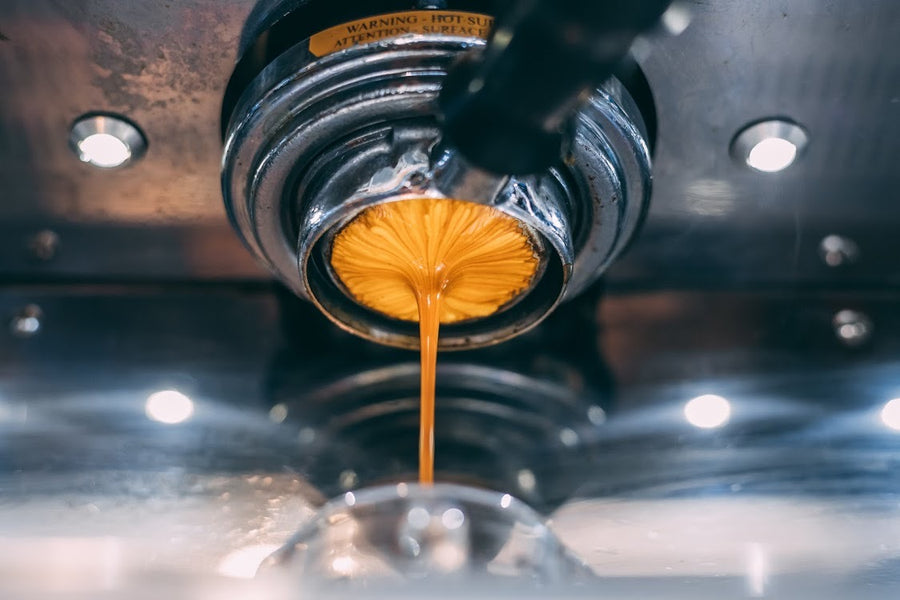Recognizing Coffee Beans: the Journey From Coffee to Blended Coffee Beans

The Beginnings of Coffee: An International Point Of View
While you may assume of coffee as a modern staple, its origins trace back centuries, intertwining with cultures around the world. The tale begins in Ethiopia, where legend claims a goat herdsman named Kaldi discovered the stimulating impacts of coffee beans after observing his goats frolicking energetically after consuming them. This triggered rate of interest, causing coffee's infect Arab investors who cherished the brewed drink. By the 15th century, it got to Persia, Egypt, and Turkey, where coffeehouses came to be social hubs for conversation and culture.
As trade routes broadened, coffee made its way to Europe in the 17th century, rapidly acquiring appeal. It transformed from a magical drink right into a day-to-day ritual, motivating celebrations and intellectual exchanges. Each culture added its distinct spin to coffee prep work, enriching its background. This worldwide journey highlights how coffee connects us, transcending boundaries and joining diverse traditions with a simple bean.
Farming and Harvesting of Espresso Beans
As coffee's trip progressed, the emphasis changed to the farming and harvesting of certain bean ranges, specifically those used for coffee. You'll find that espresso beans often come from Arabica or Robusta plants, each offering distinctive flavors. The perfect expanding conditions include high elevations and rich, well-drained soil, which improve the beans' top quality.
Throughout the harvest, choosing approaches vary. Timing is important; you want to collect when the cherries reach peak perfection for maximum taste.
As soon as collected, the beans are planned for handling, which is important in establishing their last preference. Comprehending the farming and collecting procedures provides you insight right into what goes into your preferred coffee, enriching your gratitude for each and every cup.
Processing Approaches: From Cherry to Bean
Currently that you have actually found out about collecting espresso beans, let's explore how those cherries transform right into the coffee beans you love. You'll see how different harvesting techniques influence taste, complied with by the crucial actions of fermentation and drying out. We'll break down the milling and grading procedure that determines your coffee's high quality.
Collecting Techniques Clarified
When it pertains to coffee, understanding harvesting strategies is important, given that they straight affect the flavor and high quality of the beans you delight in. There are 2 primary approaches: careful selecting and strip selecting. Selective selecting involves hand-picking only ripe cherries, ensuring you obtain the very best high quality beans. This approach usually causes a richer taste profile, though it's even more labor-intensive. On the various other hand, strip picking methods collecting all cherries simultaneously, despite perfection. While it's quicker and less costly, this can cause a mix of flavors, influencing the final product. Inevitably, the selection of collecting method can greatly affect your coffee experience, so it's worth recognizing how those beans made it to your cup.
Fermentation and Drying Out
After harvesting, the following action in handling coffee beans play a considerable role in shaping their flavor. You'll locate that fermentation is important, as it helps damage down the mucilage bordering the beans, boosting their preference account. Depending on the approach, this procedure can last from a couple of hours to numerous days, with varying results based on temperature level and humidity.
Sun-drying enables the beans to absorb tastes from the atmosphere, while mechanical drying out warranties consistent moisture degrees regardless of weather. Proper drying out is crucial to protect against mold and preserve the beans' quality, inevitably affecting your mug of coffee.
Milling and Grading Process
As fermentation and drying out set the phase for taste advancement, the milling and grading process warranties that just the most effective coffee beans make it to your cup. This phase includes getting rid of the outer layers of the coffee cherry, consisting of the parchment and husk. After milling, the beans are sorted by size and weight, guaranteeing a consistent high quality. You'll locate that grading assists recognize problems and classify beans, which affects taste and fragrance. Top quality beans obtain a higher quality, resulting in a richer coffee experience. Once rated, the beans await product packaging and delivery, maintaining their special characteristics. This careful procedure is necessary for supplying the phenomenal taste you appreciate in every sip of your favorite mixture.
Roasting Techniques: Opening Taste Prospective
When you roast coffee beans, the approach you select can considerably impact the taste profile. Understanding the partnership between time, temperature, and toasting methods is crucial to exposing the possibility of your mixture. Let's discover how these elements collaborated to produce the best cup.
Roasting Techniques Described
While you might assume that all coffee roasting approaches produce the exact same results, the fact is that each method exposes special flavor possibilities in the beans. Drum roasting utilizes a rotating drum to equally distribute warm, enhancing caramelization and creating a balanced taste. Air roasting, on the other hand, distributes hot air around the beans, advertising a lighter roast with pronounced acidity.

Effect On Taste Account
Various roasting methods not just affect the process yet additionally greatly impact the flavor account of the coffee beans. Dark roasts, on the various other hand, bring out bold, smoky tastes, in some cases masking the bean's unique characteristics. Comprehending these nuances aids you value the creativity behind your mug of coffee, improving your general experience with every sip.
Time and Temperature Level Factors
To release the full flavor potential of coffee beans, both time and temperature during the toasting procedure play significant roles. When roasting, you'll discover that higher temperatures can promptly develop tastes, yet if you hurry it, you may end up with charred notes. Conversely, reduced temperatures enable for a much more steady flavor development, showcasing the beans' distinct qualities.

Timing is equally as vital; prolonging the roast also long can lead to a loss of acidity and brightness, while too brief a roast could leave the beans underdeveloped. Locating that sweet spot needs practice and trial and error. By changing these aspects, you can disclose the rich, intricate tastes hidden within each bean, producing a really amazing coffee experience.
The Art of Blending: Crafting Unique Coffee Profiles

Begin by picking a base coffee that provides a solid foundation. A bright Ethiopian bean can bring fruitiness, while a rich Brazilian coffee includes body.
As you mix, bear in mind that each combination informs a story. You're not simply making coffee; you're producing an experience. Take your time, taste regularly, and delight in the journey of uncovering your signature blend - Single Origin Espresso.
Brewing Techniques: How Preparation Influences Flavor
Blending coffee opens up a domain name of flavor possibilities, yet exactly how you make that mix can significantly influence your last mug. On the other hand, a pour-over highlights the coffee's quality and illumination, ideal for showcasing fragile notes.
Coffee, with its high pressure, creates a focused shot that highlights sweet taste and crema. If you choose a lighter mixture, take into consideration a chilly mixture method; it generates a smooth, less acidic taste.
Eventually, experimentation is vital. Adjusting variables like water temperature level, grind dimension, and make time can transform your coffee's account. So, Single Origin Espresso embrace the art of developing to find the flavors concealed in your coffee blends. The right method can raise your experience to brand-new elevations.
The Future of Coffee: Sustainability and Advancement
As the coffee market evolves, sustainability and development are becoming necessary for addressing environmental difficulties and conference consumer demands. You'll see that more coffee firms are adopting environment-friendly practices, from sourcing beans ethically to applying sustainable farming techniques. These changes not just aid the earth yet likewise improve the quality of the coffee you enjoy.
You may see innovations like naturally degradable product packaging and water-saving brewing methods that lower waste. Advanced innovation, such as blockchain, is likewise becoming preferred, making sure transparency in the supply chain, which permits you to map your coffee back to its beginnings.
Additionally, purchasing local communities and sustaining farmers with fair profession efforts cultivates an extra sustainable coffee environment. As you drink your next cup, bear in mind that your options can add to a brighter future for coffee. By selecting sustainable brand names, you're not simply delighting in a drink; you're making a positive influence on the world.
Frequently Asked Questions
What Is the Distinction Between Arabica and Robusta Beans?
Arabica beans are smoother, sweeter, and have a higher acidity, while robusta beans are more powerful, more bitter, and have more high levels of caffeine. When brewing your coffee., you'll discover these differences in taste and scent.
Just How Does Elevation Affect Coffee Bean Taste?
Elevation impacts coffee bean taste significantly. Greater altitudes create beans with brighter level of acidity and facility flavors, while reduced altitudes commonly yield beans that are larger and much less nuanced. You'll observe these distinctions in your mug!
What Are the Wellness Advantages of Drinking Coffee?
Consuming alcohol coffee can increase your energy, boost mental focus, and even enhance physical efficiency. It's rich in anti-oxidants, may lower the danger of specific diseases, and can advertise a much healthier metabolic rate when consumed in small amounts.
Can Coffee Beans Be Reused for Brewing?
Yes, you can reuse coffee beans for developing, however the taste may be weaker. If you delight in exploring, try recycling them in different means, like cold mixtures or including in healthy smoothies for an additional kick.
Just how Should I Shop Coffee Beans for Freshness?
To keep your coffee beans fresh, store them in an airtight container in a trendy, dark area. Prevent revealing them to light, warm, or dampness, as these variables can swiftly weaken their flavor and fragrance.
Understanding Coffee Beans: the Journey From Espresso to Blended Coffee Beans.
Currently that you've discovered regarding collecting espresso beans, allow's discover how those cherries change into the coffee beans you love.When you roast coffee beans, the approach you pick can drastically affect the flavor account - Single Origin Espresso.While you might think that all coffee roasting methods produce the very same outcomes, the fact is that each method exposes special taste potentials in the beans.Different roasting approaches not just influence the procedure however likewise substantially impact the taste account of the coffee beans